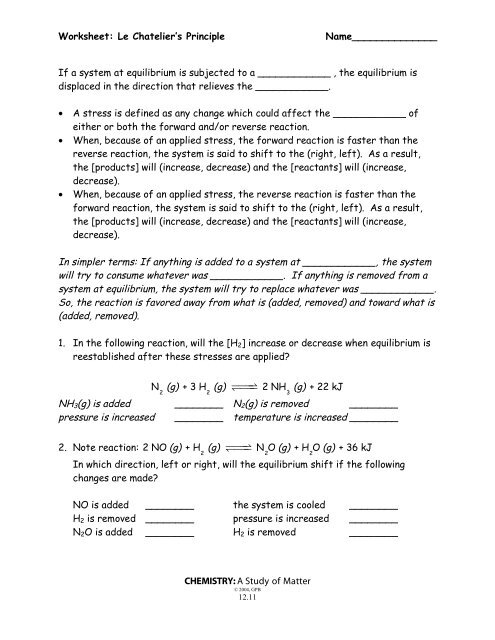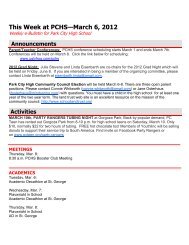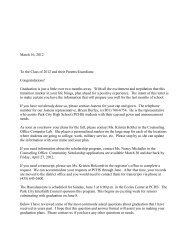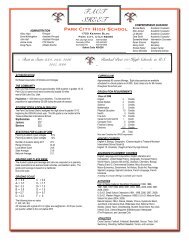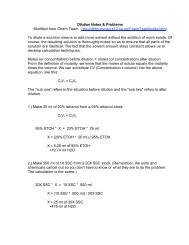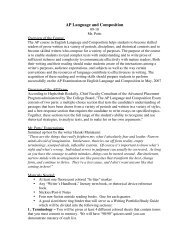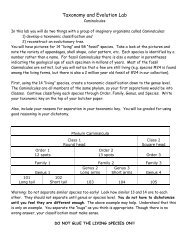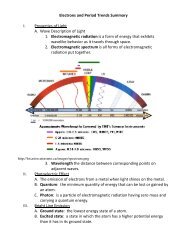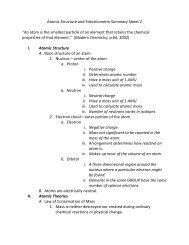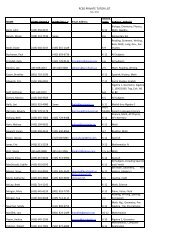Worksheet: Le Chatelier's Principle Name______________ ...
Worksheet: Le Chatelier's Principle Name______________ ...
Worksheet: Le Chatelier's Principle Name______________ ...
Create successful ePaper yourself
Turn your PDF publications into a flip-book with our unique Google optimized e-Paper software.
<strong>Worksheet</strong>: <strong>Le</strong> Chatelier’s <strong>Principle</strong><br />
<strong>Name</strong>______________<br />
If a system at equilibrium is subjected to a ____________ , the equilibrium is<br />
displaced in the direction that relieves the ____________.<br />
• A stress is defined as any change which could affect the ____________ of<br />
either or both the forward and/or reverse reaction.<br />
• When, because of an applied stress, the forward reaction is faster than the<br />
reverse reaction, the system is said to shift to the (right, left). As a result,<br />
the [products] will (increase, decrease) and the [reactants] will (increase,<br />
decrease).<br />
• When, because of an applied stress, the reverse reaction is faster than the<br />
forward reaction, the system is said to shift to the (right, left). As a result,<br />
the [products] will (increase, decrease) and the [reactants] will (increase,<br />
decrease).<br />
In simpler terms: If anything is added to a system at ____________, the system<br />
will try to consume whatever was ____________. If anything is removed from a<br />
system at equilibrium, the system will try to replace whatever was ____________.<br />
So, the reaction is favored away from what is (added, removed) and toward what is<br />
(added, removed).<br />
1. In the following reaction, will the [H 2 ] increase or decrease when equilibrium is<br />
reestablished after these stresses are applied?<br />
N 2<br />
(g) + 3 H 2<br />
(g) #! !!"<br />
! 2 NH 3<br />
(g) + 22 kJ<br />
NH 3 (g) is added ________ N 2 (g) is removed ________<br />
pressure is increased ________ temperature is increased ________<br />
2. Note reaction: 2 NO (g) + H 2<br />
(g) #! !!"<br />
! N 2<br />
O (g) + H 2<br />
O (g) + 36 kJ<br />
In which direction, left or right, will the equilibrium shift if the following<br />
changes are made?<br />
NO is added ________ the system is cooled ________<br />
H 2 is removed ________ pressure is increased ________<br />
N 2 O is added ________ H 2 is removed ________<br />
CHEMISTRY: A Study of Matter<br />
© 2004, GPB<br />
12.11
<strong>Worksheet</strong>: <strong>Le</strong> Chatelier’s <strong>Principle</strong><br />
<strong>Name</strong>______________<br />
3. In this reaction: CO 2<br />
(g) + H 2<br />
(g) + heat #! !!"<br />
! CO (g) + H 2<br />
O (g)<br />
a. Is heat absorbed or released by the forward reaction?<br />
____________<br />
b. In which direction will the equilibrium shift if these changes are<br />
made?<br />
CO is added ________ temperature is increased ________<br />
CO 2 is added ________ system is cooled ________<br />
H 2 is removed ________ pressure is increased ________<br />
catalyst is added ________<br />
4. In this reaction: 2 NO (g) + H 2<br />
(g) #! !!"<br />
! N 2<br />
O (g) + H 2<br />
O (g) + heat<br />
What will happen to the [H 2 O] when equilibrium is reestablished after these<br />
stresses are applied?<br />
temperature is increased<br />
a catalyst is added<br />
pressure is decreased<br />
NO is added<br />
N 2 O is removed<br />
________<br />
________<br />
________<br />
________<br />
________<br />
5. How would an increase in pressure affect the [H 2 ] in the following<br />
reactions?<br />
2 H 2<br />
(g) + O 2<br />
(g) #! !!"<br />
! 2 H 2<br />
O (g) __________<br />
4 H 2<br />
(g) + Fe 3<br />
O 4<br />
(s) #! !!"<br />
! 3 Fe (s) + 4 H 2<br />
O (l) __________<br />
H 2<br />
(g) + Cl 2<br />
(g) #! !!"<br />
! 2 HCl (g) __________<br />
CHEMISTRY: A Study of Matter<br />
© 2004, GPB<br />
12.12


